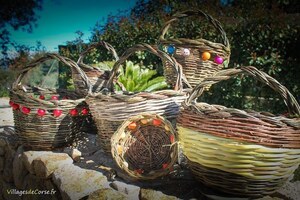
- Activities
- Craftsmanship
- Basketry
Corsican Handcrafted Basketry
From Which Tree or Shrub Does Wicker Come?
Wicker comes from the willow (Latin: salix viminalis), also known as the basketmaker's willow. It is a shrub from which young shoots are harvested in the right season to be prepared, dried, and bundled. There are several varieties with different natural colors, as well as specific properties of strength or flexibility.
Osier Cultivator
The osier cultivator is an arborist specialized in the cultivation and processing of wicker. Depending on how these willow stems are prepared, different types of wicker are produced and then sold to basket weavers. Some basket weavers carry out both activities, cultivation and crafting of wicker items, and are thus referred to as osier cultivator-weavers.
Other Materials
In artisanal basketry, wicker is not the only material used in the creation of woven items. Olive branches, myrtle, rush, and reeds split into splints while still green are also employed.
Handcrafted Baskets and Other Woven Items
With this variety of species, materials, and preparations, a wide range of objects can be woven:
- Round baskets, rectangular baskets
- Lucette basket, Périgord basket
- Fruit basket, bread basket
- Wood box, crate
- Tray, organizer
- Satchel
Simple and ecological techniques also allow for the creation of useful structures like woven fences for a small enclosure, or in a garden.
The Craft of Basketry
The craft of basketry dates back to the dawn of agriculture, its name stemming from the word van - an open wicker basket - which was used by basket weavers to winnow grains by tossing them in the air to separate them from their husks - straw, and impurities that would blow away. The ancestor of the winnowing machine, the van, which was once a tool, has evolved over time into a container of various forms we know today: wicker baskets, fruit or bread baskets, covering for dame-Jeanne, among many others.
Basketry is an artisanal craft par excellence that preserves an entirely manual ancient know-how, from the harvesting to the conditioning of plants and from weaving to drying.
Basket Weaver or Winnowing Machine Operator?
The history of basketry dates back to the Middle Ages. Those who made vans were called basket weavers, while those who used them were known as winnowing machine operators. The profession of winnowing machine operator, which involved separating grain from straw, gradually disappeared, first being replaced by the winnowing machine, then the thresher and finally the combine harvester.
Basketry Has a Future
The industrial era has transformed the artisanal world, and basketry has not been spared, with items found in stores at prices that are unbeatably low.
Amidst this trend, the profession of basketry has become increasingly rare, with currently about 300 basket weavers in France. However, a core group of artisan basket weavers persists and works in solidarity to preserve and pass on this ancestral tradition to young people who are increasingly turning back to artisanal professions. Ecology is another advantage since everything is natural, and depending on the species and preparation, different hues are obtained without any varnishing.
Map of Basket Weavers in France
The site Brin de Panier offers a map of France of basket weavers, noting that it is incomplete but provides a good indication of the number and distribution of basket weavers, with a notable concentration in Champagne.
With a rich know-how and techniques varying by region, artisanal basketry still has bright days ahead.